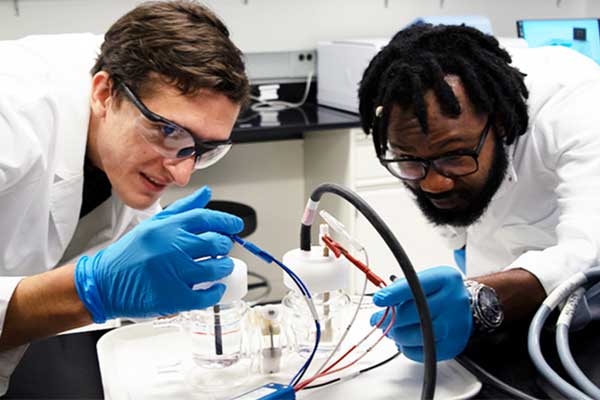- While only a mere 4% of the atmosphere, carbon dioxide plays a vital role in sustaining life on our planet.
- However, if this delicate balance is disrupted, excess carbon dioxide can pose a formidable threat to our environment and the living beings that reside within it.
- Hence, the researchers are investigating if carbon dioxide reduction reactions, converting carbon dioxide to make other carbon compounds using electricity, are feasible solutions.
While only a mere 4% of the atmosphere, carbon dioxide plays a vital role in sustaining life on our planet. However, if this delicate balance is disrupted, excess carbon dioxide can pose a formidable threat to our environment and the living beings that reside within.
A team of researchers in the Artie McFerrin Department of Chemical Engineering at Texas A&M University recently published a comprehensive review article on how carbon dioxide can be isolated through reduction reactions and then transformed into value-added chemicals for fuels, thereby providing a path to repurpose excess carbon dioxide.
“People are looking into innovative ways to mitigate global warming and minimize our impacts on the environment,” said Denis Johnson, the first author on the study and a doctoral student in the chemical engineering department. “Through scientific advancements, such as our own, we remain hopeful that one day we may be able to start reversing what has already been done.”
The research is led by Dr. Abdoulaye Djire, assistant professor in the chemical engineering department, and co-authored by Dr. Zhi Qiao, a former postdoctoral researcher for the department. The study was published in the journal ACS Applied Energy Materials.?
As Johnson suggests, a potential contributor to global warming is carbon dioxide. According to an assessment by the U.S. Energy Information Administration, unless the current energy structure is changed, carbon dioxide levels in the atmosphere will continue to increase.
Currently, there are several methods to decrease carbon dioxide’s negative impacts. One such method is decarbonization, whereby carbon is simply removed from supply chains. Despite its promise, decarbonization requires using other carbon sources, such as liquid fuels and feedstocks, deeming it unsustainable. Another method called carbon sequestration, where carbon is removed from the atmosphere, is not economically viable due to rising industry costs and the lack of technology capable of performing this task.
“Excess carbon dioxide does more harm than good,” said Johnson. “Research has found that products derived from carbon dioxide, whether they were carbon monoxide, methanol or ethanol, all have much greater use than carbon dioxide alone with the included benefit of posing less health and environmental hazards.”
Hence, the researchers are investigating if carbon dioxide reduction reactions, converting carbon dioxide to make other carbon compounds using electricity, are feasible solutions.
Carbon dioxide can be removed from emissions or the atmosphere through the use of amine columns, or similar carbon capture technologies, and purified. Once the carbon dioxide is purified, the researchers can then perform the carbon dioxide reduction reaction using a transition metal to initiate the electrochemical reaction.
Furthermore, the researchers said one of the advantages of this chemical process is that depending on which transition metal is used, copper or nickel for example, different products can be made. The carbon dioxide can be repurposed for making a variety of carbonaceous products, such as propanol for medicines or ethanol for fuels, whose value and versatilities are much more significant.
“Let’s say we get back every amount of carbon dioxide we put in, we could potentially use the carbon dioxide to produce ethanol, which can then be mixed back into fuel using recycled carbon dioxide,” said Johnson.
The article starts by reviewing the electrochemical methods currently being used to reduce the damaging effects of carbon dioxide, providing a helpful resource for other researchers in the field. The article follows with tutorials on the techniques used to help analyze the catalysts and the products of the electrochemical carbon dioxide reduction process.
“This process can fundamentally change the impacts of carbon dioxide, making it a form of renewable energy while simultaneously providing carbon sources to industries dependent on the product, reducing its negative environmental impact,” said Djire. “This work summarizes what we know about carbon dioxide recycling and transformation, and how we can carry this information into the future.”
—
Publication Referenced in the Article:
Denis Johnson, Zhi Qiao, Abdoulaye Djire. Progress and Challenges of Carbon Dioxide Reduction Reaction on Transition Metal Based Electrocatalysts. ACS Applied Energy Materials, 2021; 4 (9): 8661 DOI: 10.1021/acsaem.1c01624
—
This article was written by Texas A&M University.















Comments